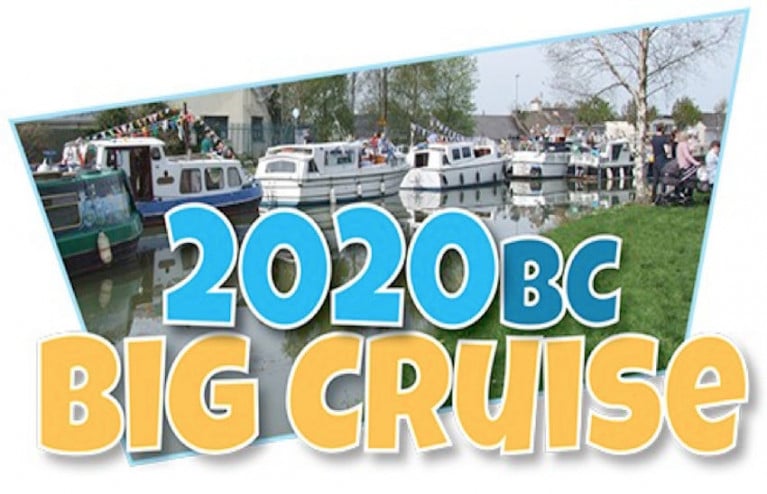Displaying items by tag: Green & Silver
New Year’s Day Flotilla To Launch 2020 Big Cruise Calendar For ‘Green & Silver’ Inland Navigations
The Inland Waterways Association of Ireland (IWAI) is ringing in the New Year with the launch of its 2020 Big Cruise calendar of events on the inland waterways of the Green & Silver route.
A flotilla of light and fast boats set off at pace on the River Liffey from the sea lock at Grand Canal Dock to Seán Heuston Bridge below Heuston Station this lunchtime (Wednesday 1 January) to kick off the 2020BC initiative.
The date also marks the 60th anniversary to the day the Grand Canal was closed to commercial traffic by CIÉ.
2020BC will centre around a calendar of waterside community celebrations and events to which boaters and other waterway users can travel next year.
This reflects the navigation circuit being very much ‘open for business’ for leisure, pleasure and amenity use.
The 2020BC project is being co-ordinated for IWAI Dublin by longtime waterways advocate Mick Kinahan with support from IWAI’s Kildare, Offaly, Shannon Harbour, Royal Canal and Barrow Branches.
Today’s flotilla also carries some offerings from the Grand Canal to Heuston Station — symbols from locations along the canal’s length, of both past and present commercial and leisure activities.
Little known outside the boating community, the Grand Canal is also part of what is known as the Green & Silver: a navigation route comprising the Royal Canal, Camlin River, River Shannon, Grand Canal and River Liffey — and one that the IWAI is keen to promote during 2020BC and beyond.
IWAI president Alan Kelly said: “We are fortunate in IWAI to have experienced volunteers who are fully committed to the promotion of our waterways for the common good and the socio-economic benefit of all.
“We also have an excellent working relationship with Waterways Ireland and with Government departments, local authorities, development associations and community organisations all along the inland waterways network.
“We look forward to 2020 being a year of further positive engagement with all of our waterways partners to promote the development and improvement of our waterways.”
Jim O’Riordan, IWAI Dublin chairperson, added: “IWAI Dublin look forward to 2020BC and are grateful for the support from our peer IWAI branches around the inland waterways network for the project.
“We also want to thank Waterways Ireland who have been involved in helping us plan today’s launch and events for the coming year; and Clontarf and Poolbeg yacht clubs among others who have assisted arrangements for the launch flotilla.
“For 2020BC, what we are promoting is not just about boating, we intend to work with as many communities as possible to develop their interests further in the inland waterways in their vicinities and look forward to meeting many new waterways friends.”
Full details of events for 2020BC will be made available on the IWAI website.
‘Green & Silver’ Canal Rally In Works For Summer 2019
The Dublin branch of the Inland Waterways Association of Ireland is working on plans for a rally this summer inspired by the Green & Silver route.
2019 marks the 70th anniversary of the publication of Green & Silver by LTC Rolt, a book which recounted an influential voyage in 1946 from the Shannon to Dublin along the Grand Canal, then back to the Shannon via the Royal Canal, including a turn north to Lough Key and south again to Lough Derg.
The 356km inland waterways route has since become known as the ‘Green & Silver Challenge’ and has been championed by IWAI Dublin since the full navigation of the Royal Canal was reopened in 2010.
Now the Dublin branch is looking to encourage as many boats as possible to join the rally from this May “to show the canals are being used and not just a pretty water feature”.
A provisional date for boats heading to Dublin on the Royal Canal to meet at the 12th Lock in Castleknock has been set for Friday 3 May, with boats on the reverse route along the Grand Canal to meet at Lucan’s 12th lock on Friday 10 May.
Boats would converge on the River Liffey for a two-day rally on the weekend of 18-19 May, with boats heading out on the Grand Canal the following weekend (25-26 May) and on the Royal Canal the week after that (1-2 June).
Prizes are being commissioned for boats that have completed the trip several times, with more on this and confirmed dates for the rally to come from IWAI Dublin in the coming weeks.





























































